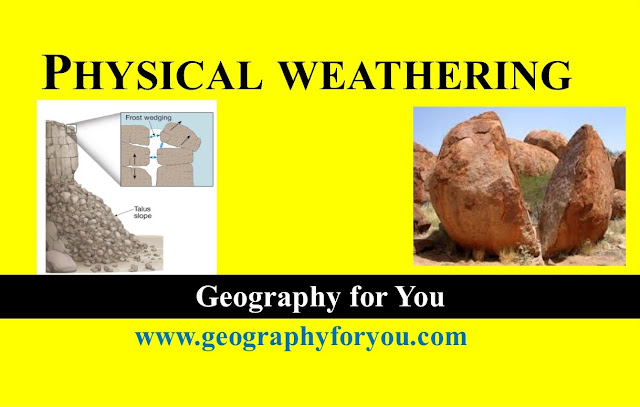Geomorphology
Physical weathering
World Geography
Physical weathering
Saturday, August 12, 2017
 |
| Physical weathering |
Introduction-
The Earth’s
surface is constantly changing It is a dynamic environment Plate tectonics and
volcanism create mountains Chemical decay and physical breakup, combine with rainfall, ice, snow, wind and gravity to
wear away those mountains.
Surface Processes
There are 3 major surface processes
that continually breaking rock apart and moving the debris to lower elevations
➽Weathering
➽Mass wasting
➽Erosion
➤Weathering is the general
process by which rocks are broken down on the Earth’s surface
➤Mass wasting is the transfer
of rock and soil down slope under the influence of gravity
➤Erosion is the physical
removal of rock and soil by water, wind, or ice All three processes can act at the same time.
Weathered MountainsThe Appalachian Mountains in eastern North America once towered more than 9,000 meters (30,000 feet) high—taller than Mount Everest! Over millions of years, weathering and erosion have worn them down. Today, the highest Appalachian peak reaches just 2,037 meters (6,684 feet) high. (National Geographic)
Three Types of Weathering
> Physical weathering
> Chemical weathering
> Biological weathering
➤ Physical weathering
Mechanical weathering is the
physical breakup of rocks into smaller and smaller pieces without changes in
the rocks’ composition. Mechanical breakup increases surface area and surface
to volume ratio. The more surface that is exposed, the greater the opportunity
for weathering.
➜Rocks commonly have natural zones
of weakness along which they tended to crack
➜Joints are large cracks that form
in rocks
➜Joints expose more surface area
which speeds up weathering
➜Repeated cycles of freezing and
thawing are a major source of mechanical weathering
➜Liquid water expands by 9% in
volume when it freezes
➜Water freezing in a confined space
exerts a tremendous amount of pressure
➜The cliff is slowly eroded away by repeated
cycles of freezing and thawing. This processes is also called frost wedging.
➜Over geologic time, the cliff will be
completely destroyed. The rocky debris piles up at the base of the cliff in an accumulation
called a talus slope.
➜In a very hot desert environment,
the daily cycle of heating and cooling can eventually crack small rocks and
pebbles.
➜It is believed that some type of
chemical weathering may have weakened the rocks and pebbles making them more
susceptive to breakage.
➜When large masses of igneous rocks are
exposed, especially granite, concentric slabs begin to break loose in a process
called sheeting. When the deeply buried pluton is exposed on the surface,
the igneous mass is subject to sheeting weathering.
➜A similar process called exfoliation
can occur on a smaller scale with thin slabs breaking off of an exposed rock
like a peeling onion.
LIKE OUR FACEBOOK PAGE- GEOGRAPHY
Previous article
Next article
